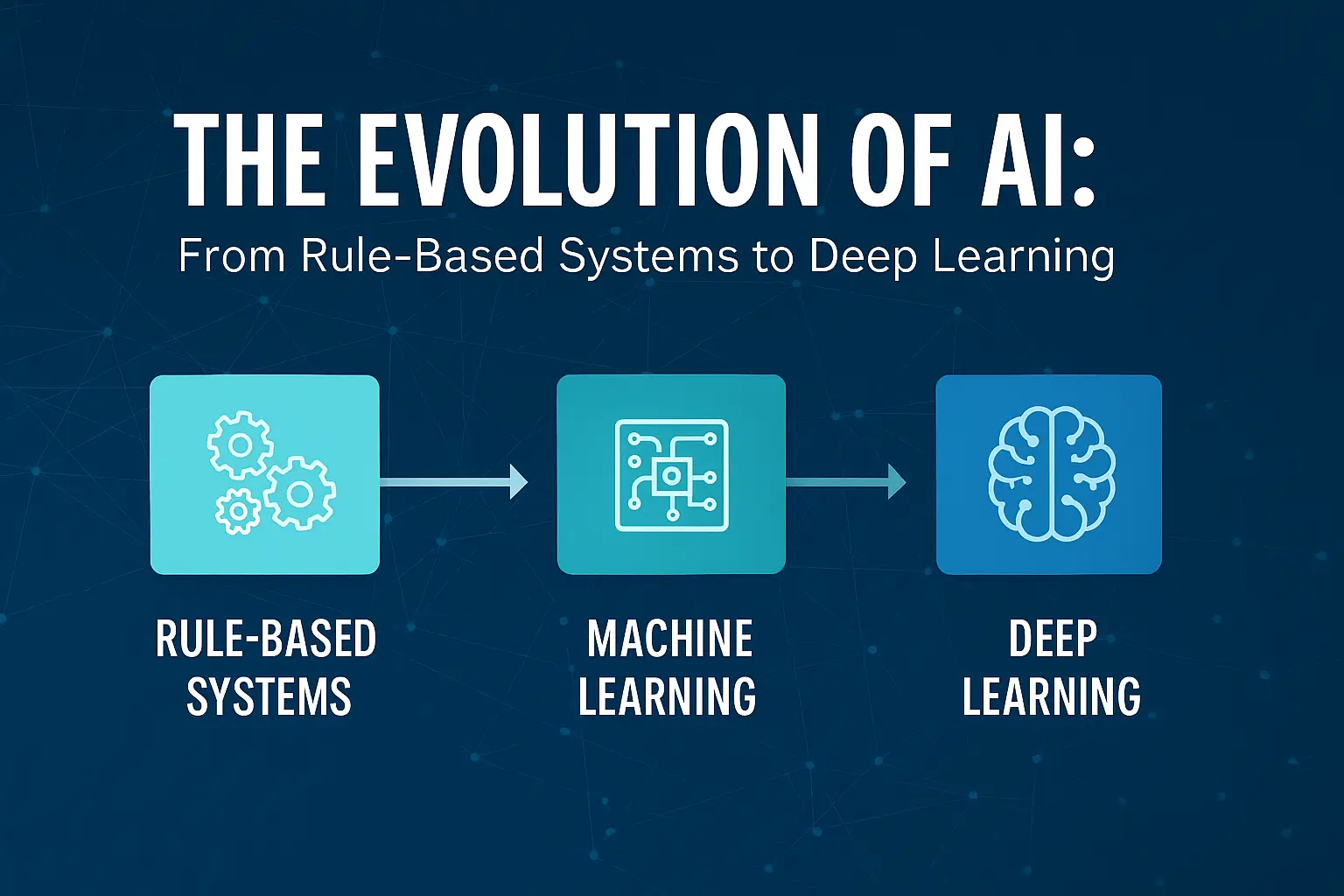Artificial Intelligence (AI) has undergone a remarkable transformation since its early beginnings. What started as simple rule-based systems has evolved into sophisticated deep learning models that now power voice assistants, self-driving cars, and intelligent recommendation engines.
This article explores the journey of AI, highlighting how it has developed over the decades—from static rules to dynamic learning—and why that evolution matters.
Early AI: Rule-Based Systems
What Are Rule-Based Systems?
The earliest form of AI, developed in the 1950s through the 1980s, was based on explicit rules and logic. These systems operated by applying “if-then” statements to make decisions.
Example:
If “temperature > 38°C,” then “display warning: fever.”
Characteristics:
- Hand-coded logic: Human programmers created all the rules.
- Limited flexibility: Could not adapt to new situations without manual updates.
- Deterministic: Always produced the same output for a given input.
- No learning: Systems couldn’t improve or evolve over time.
Used in:
Expert systems (like MYCIN for medical diagnosis), early robotics, and automation.
Next Phase: Machine Learning (ML)
What Is Machine Learning?
By the 1990s, researchers began teaching machines to learn from data rather than rely solely on predefined rules. Machine Learning algorithms use statistical methods to identify patterns and make predictions.
Example:
Instead of coding rules for spam detection, an ML model learns from thousands of labeled spam and non-spam emails.
Key Features:
- Data-driven: Models learn from past examples.
- Probabilistic: Produces outputs based on learned likelihoods.
- Adaptable: Improves with more data.
- Versatile: Used for classification, prediction, and clustering tasks.
Popular Algorithms:
Decision trees, support vector machines, k-nearest neighbors, linear regression
The Breakthrough: Deep Learning
What Is Deep Learning?
Deep Learning is a subset of Machine Learning that uses multi-layered artificial neural networks to model complex patterns in data. Inspired by the human brain, these networks can handle unstructured data such as images, audio, and text.
Key Characteristics:
- Neural networks with many layers (“deep”)
- Massive data requirements
- Requires high computational power (GPUs, TPUs)
- Self-improving with backpropagation and gradient descent
Transformative Applications:
- Image and speech recognition
- Natural language processing (e.g., ChatGPT, BERT)
- Autonomous vehicles
- AI-powered healthcare diagnostics
- Real-time translation
Landmark Innovations:
- 2012: AlexNet wins ImageNet competition, igniting the deep learning revolution.
- 2018: BERT enables deep contextual understanding of language.
- 2020s: GPT-3 and GPT-4 demonstrate large-scale language generation.
Timeline of AI Evolution
| Era | Technology | Key Features |
|---|---|---|
| 1950s-1980s | Rule-Based Systems | Hand-coded logic, expert systems |
| 1990s-2010s | Machine Learning | Data-driven, statistical models |
| 2012-present | Deep Learning | Neural networks, big data, NLP |
Why the Shift Matters
1. From Static to Adaptive
Early AI followed rigid instructions. Today’s AI learns, evolves, and adapts—making it suitable for dynamic, real-world environments.
2. From Narrow to Versatile
Rule-based systems were limited to specific tasks. Deep learning enables general-purpose models that can perform diverse functions across industries.
3. From Human-Coded to Data-Coded
We no longer need to program every decision. Instead, we feed AI data and it “learns” the patterns—automating intelligence itself.
Current State: Hybrid AI Systems
Many modern AI solutions combine rule-based logic with deep learning models.
Example:
A virtual assistant might use:
- Rules for basic commands like “set alarm”
- Deep learning for understanding free-form language or predicting user intent
This hybrid approach offers the best of both worlds: predictability and adaptability.
Challenges Along the Way
- Data Bias: Early models often inherited biases from training datasets.
- Interpretability: Deep learning models can be black boxes, hard to explain.
- Resource Demands: Training large models requires significant energy and hardware.
- Ethical Concerns: As AI gains power, it raises questions about fairness, privacy, and control.
The Future: Where AI Is Headed
- Explainable AI: Making models transparent and trustworthy
- Multimodal AI: Combining text, image, audio, and video understanding
- Few-shot learning: Training AI with less data
- Brain-inspired AI: Mimicking more aspects of human cognition
- Edge AI: Running AI on local devices without internet or cloud
Final Thoughts: A Journey from Logic to Learning
AI has come a long way—from following rigid rules to learning from data, adapting in real-time, and performing human-like tasks. This evolution has unlocked breakthroughs that continue to transform business, science, and society.
Understanding the past helps us navigate the future—and the future of AI is one where learning, creativity, and intelligence extend far beyond code.
